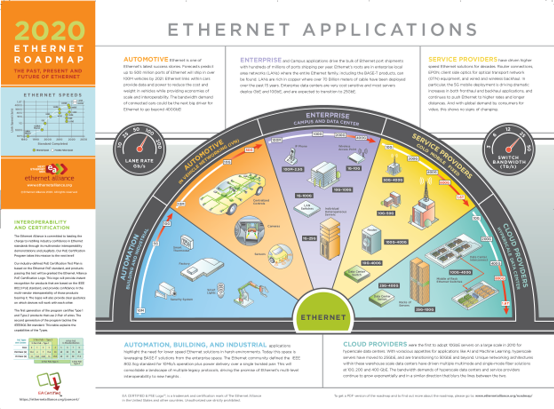2020 Ethernet Alliance Roadmap
 In 2015, the Ethernet Alliance launched the “Ethernet Roadmap” as an easy, graphical way to keep the industry informed of the updates and advancements of Ethernet’s growing ecosystem in an old-fashioned analog map format. (The ‘boomers’ get the joke, and how to refold the darn thing!)
In 2015, the Ethernet Alliance launched the “Ethernet Roadmap” as an easy, graphical way to keep the industry informed of the updates and advancements of Ethernet’s growing ecosystem in an old-fashioned analog map format. (The ‘boomers’ get the joke, and how to refold the darn thing!)
The Ethernet Roadmap has become a staple of Ethernet Alliance events ever since, presenting the industry with the latest in features, speeds and feeds, applications, interconnect solutions, and otherwise “all things ethernet.” One side of the map depicts the advancements in ethernet applications spaces; while the other side represents the changes in component solutions supporting the applications. Let’s look at these in a bit more detail.
Ethernet in the Automotive space has made great strides, offering adopters links from 10M to 10G providing power and data over the same pair of wires, enabling greater automated driver adaptations, and readying vehicles for the intelligent roadways. Reduced cost, centralized controls, additional driver safety features are all part of the plan delivering over 100M Ethernet enabled vehicles by 2021.
Industrial applications are migrating to Ethernet and PoE, and the arrival of 10 Mb/s Single Pair Ethernet (SPE) with single-pair powering will accelerate the trends in automation of factory floors and office buildings, increasing productivity and reducing energy footprints, all while consolidating legacy protocols and maintaining multi-level interoperability.
The Campus data center will benefit greatly from the advancements across BASE-T technologies and integration with 25GbE enabled storage solutions and 200GbE switches, all available today. Service providers, Hyperscale Data centers and Cloud Providers will lean in on the new 200GbE and 400GbE DC switch updates, supporting speeds and feeds starting with legacy 10GbE and offering stops at all points in between.
With the “Path to Single Lane” moving rapidly into 100GbE single lane, and beyond, the transition from NRZ (1-bit/clock) to PAM4 (2-bits/clock) signaling methods with the release of 50GbE and certain to be more challenging as we see 100GbE lanes in the very near future. A great deal of discussion and investigation for supporting rates beyond 100GbE is centering on use of Coherent signaling, surely another implementation and integration challenge for NEMs.
The interconnect community has future-proof support in the way of QSFP-DD and OSFP form factors for multi-lane communications and supporting solutions for 1 and 2 lane communications coming by way of the SFP56 and SFP-DD interfaces are ready, for both DAC and active interconnects. The myriad of interfaces and their associated nomenclature are detailed in the 2020 Roadmap as well.
The future for Ethernet is more robust than ever before. The ecosystem is coming together to create even more seamless transitions and interoperability with all stakeholders working within their respective spheres of influence to bring the promise of interoperability to the users and applications they serve.
The Ethernet Alliance 2020 Roadmap graphics are available for interested parties to use. For more details, information, and access to the Roadmap graphics please visit the Ethernet Alliance Roadmap and keep on the lookout for more content, webinars, blogs and information at https://ethernetalliance.org/.



